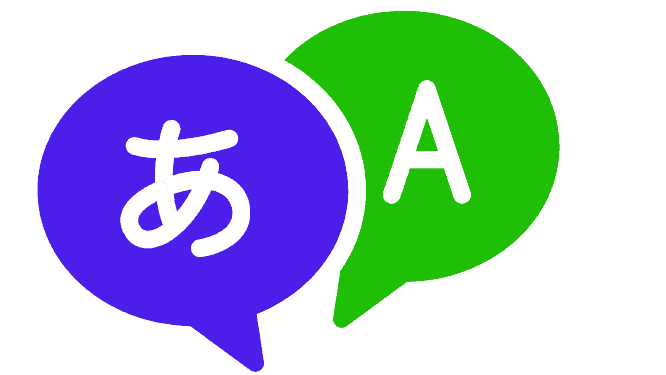Language-learning apps have made it simpler than ever to start this linguistic adventure. Duolingo’s user-friendly design, gamified approach, and efficacy in teaching languages have made it popular. The option to follow other users on Duolingo is one of the aspects that makes it unique. This tool fosters a feeling of community and offers extra inspiration and motivation for language learning. In this article, we will delve into the world of Duolingo’s follower system, focusing solely on how to follow someone on Duolingo.
Finding Users to Follow
Once you have made your Duolingo account and are ready to connect with other language learners, the next step is to find people to follow. Duolingo provides many ways to find and interact with other learners, enabling you to grow your network and engage with like-minded people. Here are some useful methods for finding folks on Duolingo to follow:
How do you search & follow for someone on Duolingo?
On Mobile/App:
- Open the Duolingo mobile app.
- Click on the Duo icon (home screen).
- You will see a Blue color Add Friends button. Click on that.
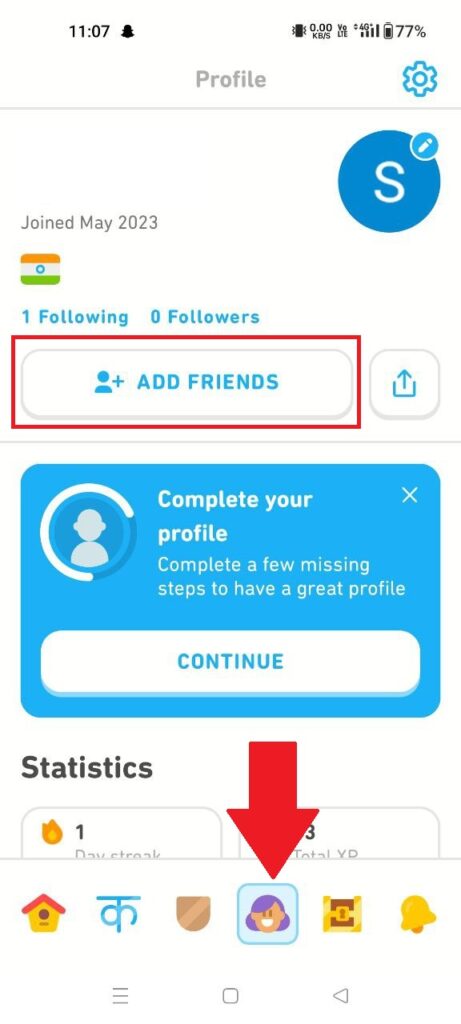
- Enter the username (if you have), name or email ID of your friend & hit enter.

- You will see many persons in the list. Click on the follow button next to your friend’s name.
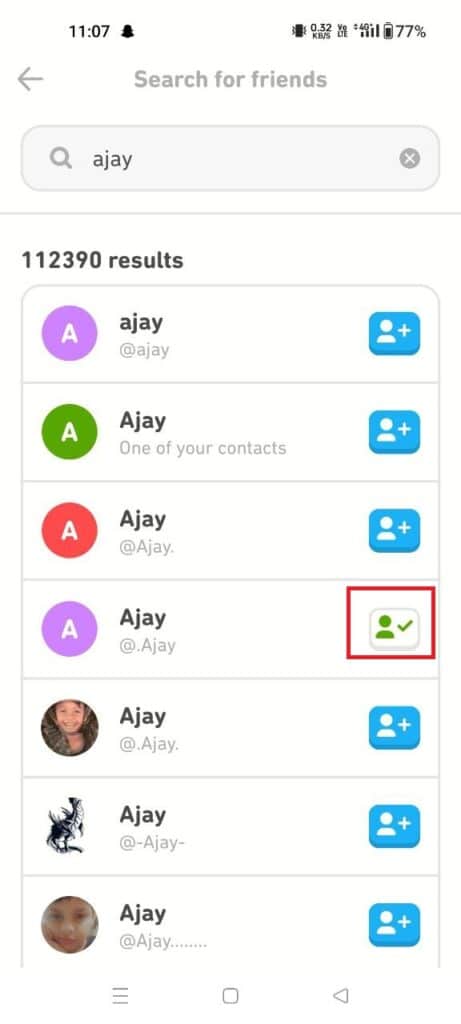
- That’s it! You are now a follower of your friend.
On PC:
- Login to the Duolingo website.
- From the left menu, click on ‘Profile’.
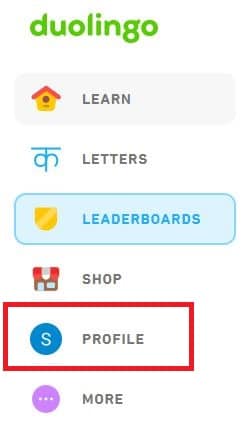
- On the right side, you will see the Friends section. Scroll down a bit & click on the “Find Friends”.

- Enter your friend’s username (if you know), name or email address & hit Enter.

- Duolingo will fetch the person(s). Click on the Follow button to follow your friend.
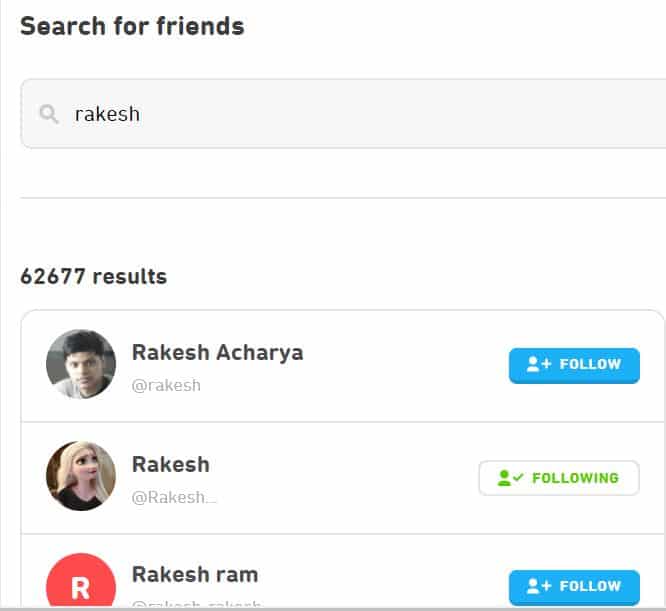
- That’s it! You are now following your friend on Duolingo.
Also See: Skipping levels on Duolingo app
Finding Duolingo Friends using other methods
1. Facebook
- Click on the Facebook friends.

- Authorize the permission.
- Duolingo will fetch all your Facebook friends who are using the platform.
- Follow them as usual.
2. Phone Contacts
- Click on the Find contacts option.
- It will ask for user permission to access your phone contacts. Allow it.
- Wait for 5-10s & Duolingo will show you the list of all your contact who are on Duolingo.
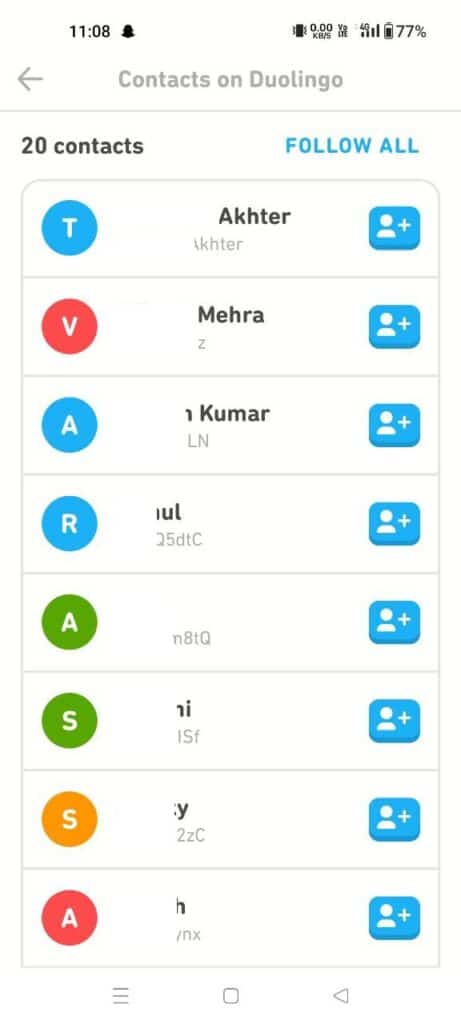
- You can follow them as you do. At the top, you will see a Follow All button. This will save you time if you want to follow all at once.
Duolingo will display the search results based on the information you provided. If the user you are looking for exists on Duolingo, their profile should appear in the search results. From there, you can navigate to their profile and choose to follow them by clicking the “Follow” button.
How to Stop Following Someone on Duolingo?
- Open the Profile section.
- You will see the list of all people who you are following in the followers section.

- Click on the name of the friend you want to unfollow.
- Next, click on the Following button to unfollow.

What happens when you follow someone on Duolingo?
- Following someone on Duolingo adds them to your Friends List, allowing you to compare your all-time XP with theirs.
- The Friends List is different from the Leaderboard, where you compete in a weekly XP competition with other Duolingo learners.
- The Friends List can be viewed on the Duolingo homepage when using the web version.
- The leaderboard displays the highest scoring friends based on all-time XP.
- The maximum number of followers allowed is currently 1000.
- If you are unable to follow others, it may be due to inactivity. Completing a lesson can resolve this issue.
- Ensure that your email is verified to have full functionality on Duolingo.
- Learners under the age of 13 and those with private profiles cannot be followed.
- Inactivity may prevent you from following others, but completing a lesson will restore the ability.
On Duolingo, following someone creates a relationship between your account and the person you’ve chosen to follow. When you follow a user on Duolingo, the following happens:
Activity visibility
You can observe someone’s activity stream by following them. This entails that you may see their accomplishments, courses completed, and any updates they wish to publish, as well as their language learning progress. The activity stream gives you a glimpse into their path and keeps you informed of their language-learning successes.
Competition & Leaderboards
You can compete amicably on Duolingo by following other users. You can assess your accomplishments in relation to those of the individuals you follow. On occasion, Duolingo also provides challenges and leaderboards where you can compete against the individuals you follow and other users of the site.
Community
Follow other users on Duolingo to build a feeling of community and support. It enables you to make connections with others who share your views, ask for counsel, and encourage others. You’re able to connect, ask questions, exchange thoughts, and get language-learning help by connecting with the people you follow.
Mutual Inspiration
On Duolingo, following others inspires and motivates you. Observing other students’ growth and successes might motivate you to stick with your language learning objectives. You are reminded that you are not alone in your language-learning journey as a result of the feeling of community and shared experience it fosters.
New: Duolingo Quests Feature
With the introduction of “Friends Quests,” a brand-new feature on Duolingo, language learning has never been more fun or social. According to studies, Duolingo users who follow friends have a 5.6 times higher chance of finishing their language courses. Learners who follow friends on Duolingo can track their development and provide encouragement when they hit certain milestones. Now that Friends Quests are available, students can collaborate together to overcome obstacles.
Engaging in Friends Quests: Collaborative Challenges on Duolingo
Friends Quests are weekly tasks that at random assign students to one of their Duolingo pals. Every week, a different task is given, such as gaining a certain amount of XP or finishing a series of flawless lessons. The challenge must be completed within five days for participants to get a gratifying prize. Students might help and assist their buddy throughout this period to ensure that both of them accomplish the quest and get a large prize.
The Power of Social Features
The social aspects of Duolingo, such as adding friends and recognizing learning accomplishments, have been shown to improve the learning experience. Friends Quests provide students another chance to study with their pals, even if they are studying different languages. As students collaborate to achieve a common objective and depend on one another for inspiration and support, it promotes a feeling of camaraderie.
Weekly Pairings and Unique Challenges
On Tuesdays at 1 p.m. EST, learners are automatically matched with friends to engage in Friends Quests, providing they have finished at least one course for the week. It is crucial to have the most recent version of the iOS or Android app since Friends Quests are not yet accessible on Duolingo’s website. Each week brings new friends to team up with, ensuring that learners have the opportunity to collaborate with different individuals and expand their network.
It’s simple to start a conversation with a new Friends Quest companion, thanks to Duolingo’s “nudges” function. Nudges are pre-written remarks that students may send to a new buddy to greet them or to remind them to finish their practice. In addition, students can assist their Friends Quest companion by giving them an XP boost. By tapping the gift button in the Friends Quest module, learners can use their gems to send a surprise XP boost to a friend, which can be encouraging and could lead to a return favor.
Friends Quests and the Monthly Goal
Friends Quests help students grow and count toward their monthly goal. It really provide more “Quest Points” than daily tasks, hastening the acquisition of the gleaming badge linked to the monthly goal. Friends Quest completion helps learners advance in their language learning process and gives them a feeling of success.
On occasion, students may ponder why they were not matched for a Friends Quest with their closest buddy. It can be because their companion isn’t actively using Duolingo for practice. Duolingo matches students with peers who are actively using the language to enable mutual involvement and encouragement.
If all of a learner’s friends are doing a Friends Quest for the week, it’s a great chance to meet new people on Duolingo. By synchronizing their contacts or linking Duolingo to Facebook, learners may boost their chances of being partnered with new friends in the coming weeks. This enriches the learning experience and connects students with other language aficionados.
Encouraging Engagement and Support
Friends Quests are a great way to interact with friends and increase motivation, but Duolingo is aware that not everyone may want to take part. If a learner would rather not participate in Friends Quests, they may choose not to. By accessing the Profile tab, clicking on the gear icon, and scrolling down to the “General” section, learners can easily toggle off the “Friends Quest” feature according to their preference.
Friends Quests on Duolingo have completely changed how students communicate and work together with their pals. These quests allow learners to assist one other, measure progress, and take on challenges. Duolingo’s Friends Quests boost responsibility and incentive, improving language learning. Friends Quests allow students to learn, develop, and celebrate together.
Can people find you on Duolingo?
Yes, people can find you on Duolingo depending on your privacy settings. Users of Duolingo have the opportunity to interact with and follow one another since it is supposed to be a social language-learning tool. Here’s how people can find you on Duolingo:
Each user of Duolingo receives a unique username. If someone knows your username, they may use it to look for your profile on the Duolingo app or website. Using their usernames, you can find other people as well.
Email Address: Other users could be able to search your email address if you have connected it to your Duolingo account. This depends on your privacy settings and whether you have chosen to make your email address visible to others. Users could locate your profile by typing in your email address.
Public Profile: If your privacy settings allow it, other Duolingo users may find your profile by searching or browsing the community. Your username, profile photo, progress in your language, and accomplishments are often shown on public profiles. Nevertheless, depending on your privacy settings, certain personal information, including your complete name or contact information, could not be available.
It’s important to note that Duolingo gives users the option to modify their privacy settings in order to manage who may see their profile and personal data. You can choose whether you want your profile to be public, viewable solely to your followers, or even more private by limiting who can see it. Control who can find and engage with you on Duolingo by changing your privacy settings.
Privacy and Security Considerations
Although Duolingo offers a platform for engaging with other language learners and creating a welcoming community, it’s crucial to put your privacy and security first when communicating with individuals who have followed you. The following factors and advice can help you have a safe and secure experience on Duolingo:
Changing Privacy Preferences
If you don’t want to follow or unfollow users, you have to change the privacy of your Duolingo account. By doing so, you restrict the visibility of your account to the general public. We have already written a detailed article on making your Duolingo account private.
Blocking or Unfollowing Users
You have the choice to unfollow or block a person on Duolingo if they engage in any conduct that you find offensive or is against Duolingo’s community standards.
- Find the “Unfollow” or “Block” option on the user’s profile by visiting it.
- To delete someone from your followers list or prevent them from communicating with you, click on the relevant option.
- It’s essential to unfollow or ban individuals who act inappropriately or make you feel uncomfortable on Duolingo in order to keep a good and secure experience there.
Conclusion
In conclusion, following someone on Duolingo creates options for community engagement, encouragement, and inspiration. Following others lets you compare progress, compete, and exchange resources. It’s important to prioritize privacy and security by managing privacy settings, being careful with personal information, and reporting inappropriate behavior. Duolingo allows language learners to collaborate, learn from one other, and create a friendly community.
FAQs
Go to someone’s profile page on Duolingo and search for the “Follow” button. Clicking on it will establish a connection between your accounts, and their updates will appear on your activity feed.
No, Duolingo does not notify users when someone starts following them. Following someone is a private action, and only you have access to the list of users you follow.
No, Duolingo presently only permits 1,000 followers at a time. Until you unfollow someone, you won’t be able to follow any more people after you’ve reached this cap.
If a learner’s profile on Duolingo is set to private, you cannot follow them. Their profile’s visibility is limited by privacy settings, which also prohibit others from following them.
No, following someone on Duolingo adds them to your Friends List, where you can compare all-time XP. The leaderboard is a separate feature where you compete with Duolingo learners in a weekly XP competition.
Yes, you can unfollow someone by visiting their profile and clicking on the “Unfollow” button. This action will remove them from your Friends List.
No, users who are under the age of 13 are considered age-restricted and cannot be followed on Duolingo.
No, following users on Duolingo is optional. It allows you to connect with others, share progress, and engage in a supportive community, but it is not mandatory for using the language-learning features of the platform.

Meet Bill, a French language teacher and blogger who specializes in testing various language learning apps. He has been teaching French for nearly 4 decades and holds a Bachelor’s degree from Manhattanville College. With a passion for technology and how it can enhance language learning, Bill has spent years testing and reviewing different language learning platforms. His blog provides valuable insights into the pros and cons of each app, as well as tips for language learners of all levels.
